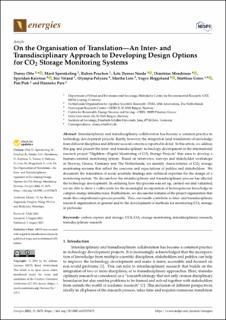| dc.contributor.author | Otto, Danny | |
| dc.contributor.author | Sprenkeling, Marit | |
| dc.contributor.author | Peuchen, Ruben | |
| dc.contributor.author | Nordø, Åsta Dyrnes | |
| dc.contributor.author | Mendrinos, Dimitrios | |
| dc.contributor.author | Karytsas, Spyridon | |
| dc.contributor.author | Veland, Siri | |
| dc.contributor.author | Polyzou, Olympia | |
| dc.contributor.author | Lien, Martha | |
| dc.contributor.author | Heggelund, Yngve | |
| dc.contributor.author | Gross, Matthias | |
| dc.contributor.author | Piek, Pim | |
| dc.contributor.author | Puts, Hanneke | |
| dc.date.accessioned | 2023-02-01T12:35:53Z | |
| dc.date.available | 2023-02-01T12:35:53Z | |
| dc.date.created | 2022-09-16T14:17:59Z | |
| dc.date.issued | 2022 | |
| dc.identifier.citation | Energies. 2022, 15 (5), . | en_US |
| dc.identifier.issn | 1996-1073 | |
| dc.identifier.uri | https://hdl.handle.net/11250/3047722 | |
| dc.description.abstract | Interdisciplinary and transdisciplinary collaboration has become a common practice in technology development projects. Rarely, however, the integration (and translation) of knowledge from different disciplines and different societal contexts is reported in detail. In this article, we address this gap and present the inter- and transdisciplinary technology development in the international research project “DigiMon—Digital Monitoring of CO2 Storage Projects” that aims to develop a human-centered monitoring system. Based on interviews, surveys and stakeholder workshops in Norway, Greece, Germany and The Netherlands, we identify characteristics of CO2 storage monitoring systems that reflect the concerns and expectations of publics and stakeholders. We document the translation of social scientific findings into technical expertise for the design of a monitoring system. We discuss how the interdisciplinary and transdisciplinary process has affected the technology development. In outlining how this process was set up, carried out and validated, we are able to show a viable route for the meaningful incorporation of heterogeneous knowledge in complex energy infrastructures. Furthermore, we discuss the features of the project organization that made this comprehensive process possible. Thus, our results contribute to inter- and transdisciplinary research organization in general and to the development of methods for monitoring CO2 storage in particular. | en_US |
| dc.language.iso | eng | en_US |
| dc.relation.uri | https://www.mdpi.com/1996-1073/15/15/5678/htm | |
| dc.rights | Navngivelse 4.0 Internasjonal | * |
| dc.rights.uri | http://creativecommons.org/licenses/by/4.0/deed.no | * |
| dc.subject | CO2-fangst og lagring | en_US |
| dc.subject | CO2 capture and storage | en_US |
| dc.title | On the Organisation of Translation—An Inter- and Transdisciplinary Approach to Developing Design Options for CO2 Storage Monitoring Systems | en_US |
| dc.title.alternative | On the Organisation of Translation—An Inter- and Transdisciplinary Approach to Developing Design Options for CO<inf>2</inf> Storage Monitoring Systems | en_US |
| dc.type | Peer reviewed | en_US |
| dc.type | Journal article | en_US |
| dc.rights.holder | © 2022 by the authors | en_US |
| dc.description.version | publishedVersion | en_US |
| cristin.ispublished | true | |
| cristin.fulltext | original | |
| cristin.qualitycode | 1 | |
| dc.identifier.doi | 10.3390/en15155678 | |
| dc.identifier.cristin | 2052549 | |
| dc.source.journal | Energies | en_US |
| dc.source.volume | 15 | en_US |
| dc.source.issue | 5 | en_US |
| dc.source.pagenumber | 22 | en_US |
| dc.relation.project | Andre: ACT international initiative, project no 299622 | en_US |
| dc.subject.nsi | VDP::Miljøteknologi: 610 | en_US |
| dc.subject.nsi | VDP::Environmental engineering: 610 | en_US |

